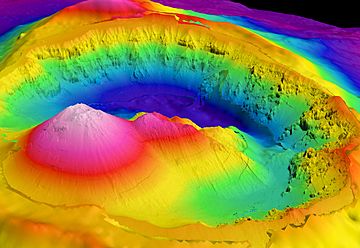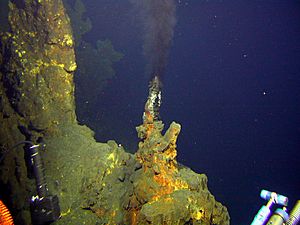Brothers Volcano facts for kids
Quick facts for kids Brothers Volcano |
|
|---|---|

Brothers Volcano as looking into the caldera from the south
|
|
| Summit depth | 1,350 m (4,430 ft) |
| Location | |
| Coordinates | 34°52′30″S 179°04′30″E / 34.875°S 179.075°E |
| Geology | |
| Type | Submarine volcano |
| Last eruption | Unknown |
The Brothers Volcano is a huge underwater volcano found in the Pacific Ocean. It's part of a chain of volcanoes called the Kermadec Arc, located about 340 kilometers northeast of New Zealand's Whakaari/White Island.
This volcano is shaped like an oval, about 13 kilometers long and 8 kilometers wide. Inside, it has a giant bowl-shaped crater called a caldera, which is 3 kilometers wide. The walls of this caldera are very tall, reaching 300 to 500 meters high. Brothers Volcano is three times bigger than the White Island volcano.
From the bottom of the caldera, which is 1850 meters (over a mile) below the sea surface, a dome of rock rises 350 meters. This dome is made of a type of lava called dacite. There's also a smaller dome nearby.
The caldera walls and the larger dome are home to many hydrothermal vents. These are like underwater hot springs that shoot hot water up into the ocean. The hot water plumes can rise as high as 750 meters! Brothers Volcano is the most active volcano with these hot springs in the Kermadec Arc.
These hot springs have created tall "black smoker" chimneys, some as high as 8 meters. They form when the hot, chemical-rich water from the vents mixes with the cold ocean water. The chemicals then cool down and settle, building up these chimney-like structures.
The hot fluids from these vents are a source of energy for many unique creatures. These include special tubeworms and bacteria that can live in extreme conditions. The amazing sea life and minerals found around these chimneys are important for New Zealand's economy and its biotechnology industry.
The Brothers Volcano was formed because of a process called subduction. This is when one of Earth's giant plates, the Pacific Plate, slides underneath another plate, the Australian Plate.
Scientists don't know exactly when Brothers Volcano last erupted. However, the shape of its crater walls suggests that its last eruption was very powerful. It was so explosive that it caused the volcano to collapse and form its large caldera. In 2007, scientists from the United States, New Zealand, and Germany worked together to create detailed maps of the volcano.
Monitoring Underwater Volcanoes
No specific group regularly watches underwater volcanoes like Brothers Volcano. However, they are becoming a very interesting topic for scientists on current ocean expeditions. Researchers want to learn more about them.
See also
 In Spanish: Volcán Brothers para niños
In Spanish: Volcán Brothers para niños


